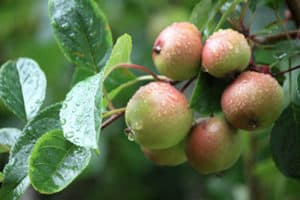Foliar sampling is a powerful tool for fertility management in the orchard.
Both plant tissue analysis and soil testing hold a piece of the puzzle that is the plant-soil relationship, neither one should be a substitute for the other. However, where soil sampling is often sufficient for row crops, plant tissue analysis, also known as foliar or leaf sampling, is a better method to use for commercial fruit crops, especially those grown as perennials.
 Perennial fruit crops are in production for several years. Their deep-root systems make it a challenge to get a good representative soil sample. Trees also store and recycle nutrients differently than their non-woody counterparts. For these reasons, it makes sense for growers to find out what is going on inside the tree, rather than over large areas of soil.
Perennial fruit crops are in production for several years. Their deep-root systems make it a challenge to get a good representative soil sample. Trees also store and recycle nutrients differently than their non-woody counterparts. For these reasons, it makes sense for growers to find out what is going on inside the tree, rather than over large areas of soil.
While soil tests are useful for determining specific problems or for pre-plant evaluation of an orchard site, foliar sampling achieves three goals:
- Signifies plant response to fertilizer treatments
- Pinpoints nutrients associated with a deficiency or toxicity
- Identifies trends or changes in nutrient status that may signal approaching problems
Sampling
“The optimum time for sampling fruit crops is mid-June to mid-August,” says Dr. Scott Johnson, extension specialist in pomology for The University of California. “This is pretty standard for fruit trees, almond and nut crops. Perennials store large quantities of nutrients during the wintertime. When leaves first come out in the spring they have high nutrient concentrations, but these levels begin to drop quickly. By mid-summer they begin to even out and you have a window for leaf sampling where there is less chance for variability.”
The accuracy of test results for foliar sampling reflects the quality of the sample taken. Two important considerations are to obtain a good representative sample and to sample the right plant part. Johnson recommends avoiding young leaves because they tend to be higher in some nutrients, instead, take samples from recently matured leaves. For good representation, a general guideline is to take a 100-leaf sample that includes no more than a couple of leaves from each tree.
For specific sample guidelines, turn to a reputable lab in your area or talk to your local extension agent. Additionally, university sites are a good source for in-depth information on proper sampling techniques for fruit crops.
Future of Plant Tissue Analysis
“One of the problems with mid-summer sampling is that it is a poor time to correct mistakes for that growing year or your harvest may already be in,” says Johnson. “Some of our current research involves sampling dormant season shoots to see if they can aid with early detection of nutrient problems. This is still very much in the research stage, but we think it holds some promise.” According to Johnson, a group of researchers in Spain is carrying out similar research on flower samples. “There is also some interest in refining the values for leaf testing because the method has been around for so long. As we move into high-production agriculture, the thinking is that these values may need to be increased in the future.”
KeyPlex is devoted to promoting overall plant health through good nutrition. The company offers a wide range of products for fruit crops, check out the KeyCard for Fruits (Deciduous) on the KeyPlex website for more information.

